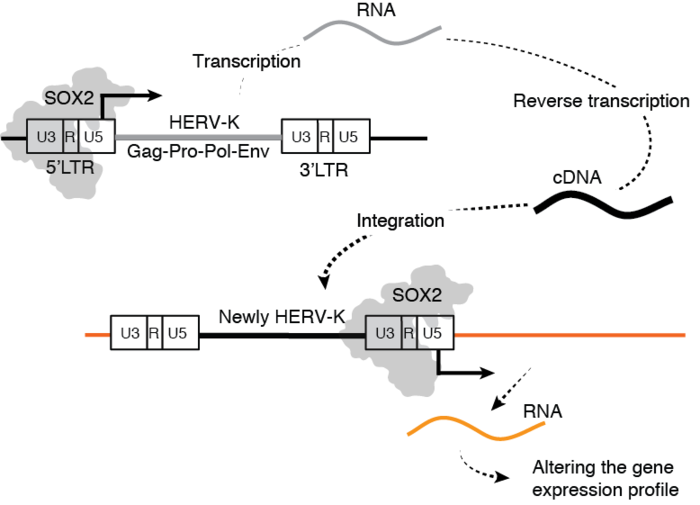Using a next generation sequencing analysis to examine human endogenous retrovirus (HERV) integration sites, researchers from Kumamoto University, the National Institute of Genetics (Japan), and the University of Michigan (USA) have discovered that these ancient retroviruses can undergo retrotransposition (DNA sequence insertion with RNA mediation) into iPS cells. The team believes that their discovery places a spotlight on a possible risk that HERVs pose when using iPS cells in regenerative medicine.

Credit: Dr. Kazuaki Monde
Using a next generation sequencing analysis to examine human endogenous retrovirus (HERV) integration sites, researchers from Kumamoto University, the National Institute of Genetics (Japan), and the University of Michigan (USA) have discovered that these ancient retroviruses can undergo retrotransposition (DNA sequence insertion with RNA mediation) into iPS cells. The team believes that their discovery places a spotlight on a possible risk that HERVs pose when using iPS cells in regenerative medicine.
The study of ancient retroviruses embedded in our genome requires knowledge about our coexistence with viral threats throughout history. We know that HERVs occupy approximately 8% of the human genome and obtain mutations and deletions over long periods. HERVs are also expressed in early embryos and play several physiological roles in human development. For example, HERV-W and HERV-FRD Env proteins are important for placental formation, and HERV-K is thought to protect host cells from exogenous retrovirus infection. However, uncontrollable HERV-K expression is also thought to be associated with various diseases, including various cancers and neurological diseases, but the details of this association is not well known in humans.
Since no one has yet discovered replication competent HERVs in our genome, it is thought that they are from an extinct (fossil) virus. In their current work, the research team from Japan and the US discovered that HERV-K is expressed in SOX2-expressing cells, such as those in early embryos, cancer stem cells and iPS cells. They also found that some HERV-K are newly integrated into the host genome in the absence of Env, the viral envelope glycoprotein. This integration was dependent on reverse transcriptase, integrase and protease, thus the researchers hypothesized that the HERV-K embedded in our genome is actually not from a fossil virus, but moves on the genome through the synthesis of proviral DNA reverse transcription. Interestingly, when the researchers compared the HERV-K integration sites between iPS and fibroblast cells from the same donor, they found new HERV-K integration sites in iPS cells. However, the new integration sites were rarely preserved and disappeared during long-term culturing. HERV-K is likely to be randomly integrated into genome, thus the possibility remains that HERV-K retrotransposed-cells predominantly survive depending on their integration site.
The movement of HERV-K on the genome might cause cancer and neurological diseases by altering the gene expression profile. The researchers believe that the risk of HERV-K transposition is low in iPS cells but suggest that monitoring HERV-K integration sites should be seriously considered to improve the safety of regenerative medicine using iPS cells.
This research was published online on 14 April 2022 in the Journal of Virology.
Journal
Journal of Virology
DOI
10.1128/jvi.00356-22
Method of Research
Experimental study
Subject of Research
Cells
Article Title
Movements of ancient human endogenous retroviruses detected in SOX2-expressing cells
Article Publication Date
14-Apr-2022
COI Statement
The authors declare no competing interests.




